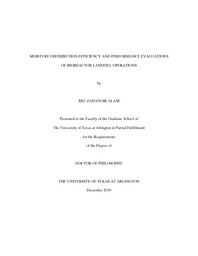| dc.description.abstract | Bioreactor landfills are operated in a modern engineered way to accelerate waste decomposition, gas production, and waste stabilization. The major aspect of a bioreactor landfill operation is associated with the addition of supplemental liquid or leachate recirculation, and the effective operation primarily depends on efficient moisture distribution throughout the waste mass, which enhances performance. The performance of an effective landfill operation can be assessed by several indicators, i.e., leachate generation, gas production, and landfill settlement. Bioreactor landfill operations have several significant economic and environmental advantages, but the impact of efficient moisture distribution and the assessment of performance through combined indicators is not well established. Hence, explaining and quantifying such impact on performance monitoring is essential to understanding an effective operation.
The overall objective of this research was to monitor moisture distribution, due to leachate recirculation, throughout the landfill and to evaluate the performance of landfill operations. Leachate recirculation was performed through horizontal recirculation pipes and vertical injection wells. The City of Denton Landfill, in Denton, Texas, USA was selected as the site for the field investigations. A field program was conducted, using the electrical resistivity imaging (ERI) technique to determine moisture variations with time (one day, one week, two weeks) due to leachate recirculation through the horizontal and vertical recirculation systems. The data of field performance indicators, i.e., leachate generation, gas production, and landfill settlement, was collected from the landfill authority and analyzed to observe the bioreactor performance. Field leachate generation was compared with the Visual HELP model results to correlate it with the gas generation. The combined effect of indicators was analyzed to evaluate landfill performance. The research provides data on the significant factors of successful bioreactor landfill operations: the application frequency of leachate, and moisture distribution efficiency due to leachate recirculation through vertical injection wells. The research develops an understanding the effect of indicators and the assessment of landfill performance through evaluating the essence of individuals and combined indicators.
Scheduling the leachate recirculation is one of the most vital actions required for distributing the moisture in the underlying waste. A comprehensive understanding of moisture variations in a bioreactor landfill, by reason of circulating leachate, is important for determining the frequency of leachate recirculation. The estimated moisture content for the baseline study was 31.5% before the next cycle of leachate recirculation to the adjacent recirculation pipe. However, the moisture content after 1 day, 7 days and 14 days after leachate recirculation was found 49.52%, 40.48%, and 31.74%, respectively.
Several recirculation systems are currently being used at different locations across the world; however, vertical injection wells are the specific objects of interest in leachate recirculation due to their potential advantages over other available systems. Based on the results of the studies pertaining to vertical wells, the initial moisture content ranged from 31.5% to 36.5% before liquid was added through the vertical wells. The moisture content observed rose from 49.5% to 64.6% within one day after the leachate injection; however, it decreased one week after leachate injection, ranging from 40.12% to 47.03%. Two weeks after leachate injection, the moisture content ranged from 31.75% to 38.6%.
The performance of bioreactor landfills can be monitored by several indicators, i.e., moisture distribution, leachate generation, gas production, water balance, and landfill settlement. Combining the different parameters to assess the performance of a bioreactor landfill has not been widely investigated. The results from the water balance simulation model, Visual HELP, show that the actual leachate generation in the field is approximately 55% lower than the HELP model results. The reason that the leachate return from the landfill is lower might be that the added water/leachate is being partially used for gas production. Hence, an increase in gas generation was observed, increasing from 543.6 m3/h (320 scfm) in 2010-2011 to 1087.3 m3/h (640 scfm) in 2014-2015. Moreover, in some locations of the landfill cells, from 2014 to 2015, an approximate total of 1.45 m (4.8 ft.) of maximum settlement was found in the landfill. | |

